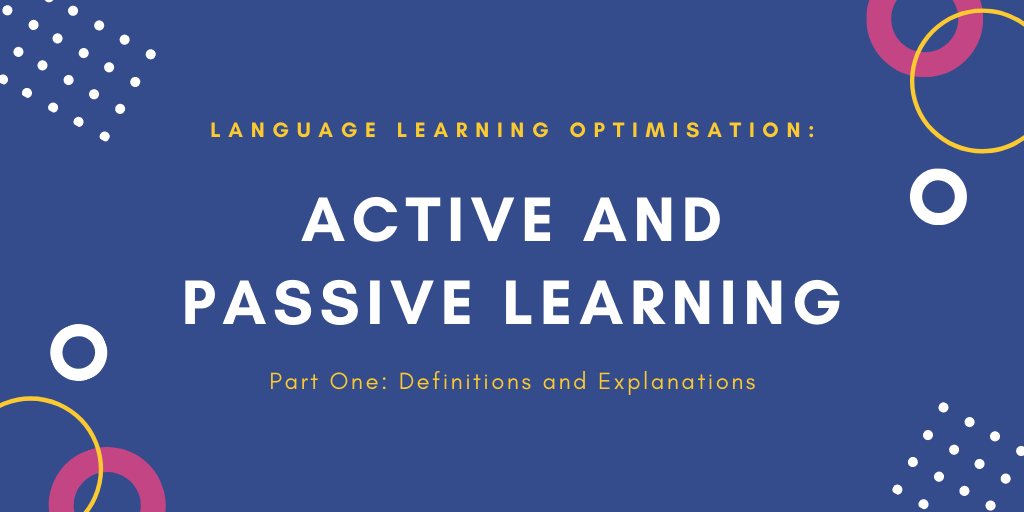Last time we talked about the differences between babies and adults and the problems we encounter in the process of the tongue acquisition. Today I would love to tell you more about how we can address these issues through an effective combination of active and passive language learning strategies.
Before we start, I would love to clarify something first. Many assume, that kids study passively and pick their mother tongue naturally, simply absorbing it through being in a language environment. However, nothing could be more wrong – children are the ultimate active learners. They are constantly asking things, trying to understand what the words mean and how the structures work. They absorb the language through the ultimately active process – speaking, correcting and repeating. They try new sounds, try new words, make mistakes and repeat everything all over again before they get things right. Even for babies, it takes months of practice and constant babbling before they can build simple sentences. And from there, few more years before they can communicate using a fluent and unconstraint speech.
Therefore, it is an illusion to think, that adults can master a language passively – even toddlers do it through engagement and constant repetition. Many research cases have also shown, that passive lessons alone are not very effective and such exercises cannot be considered a proper strategy on their own. However, we can optimise our studying time and maximise the fruits it brings by combining active and passive training approaches. Active learning + passive learning = optimal learning.
However, what does “passive” mean? In the context of language acquisition, it is: “you do not engage with the information you receive”. An example of passive studying would be watching a show with the subtitles or listening to a podcast while washing the dishes.
Of course, we, adults, don’t have the absorbing capabilities of children, therefore, we cannot remember as much and progress as quickly as kids can. However, similarly to children, we still heavily rely on statistical learning. Therefore, correctly chosen passive activities can enormously support our active lessons.
Did you know, that most adults can only recognise speech sounds present in their own mother tongue? However, through language exposure, we can retrain our ears to be able to recognise and interpret new sounds and dialogue tones. Not only this, but passive exposure also benefits us by increasing our familiarity with the language, our ability to notice and recognise various structures. The real power of passive learning lies in the creation of networks of contexts, which allow us to recall and understand the words and constructions much faster later.
Passive studying also has some additional advantages, as this type of approach is more fun and sustainable in the long run. For example, podcasts allow you to listen passively while doing something you would do anyway, without intensively tiring you out.
However, the ultimate exercise we should concentrate most of our efforts on is active learning. In such, you process the information consciously, engaging with what you have heard by, for example, writing it down. An example of active training would be talking in a language, writing your own flashcards or composing an essay.
As our ability to remember and retain information significantly decrease with our age, to be able to remember new words and structures our human brains need to be trained. Memories are formed most efficiently when you force your brain to do something, and adults especially contribute from the immersion-like lessons. Therefore, even the short periods of active “work-outs” bring amazing results when repeated regularly.
However, deep learning is very tiring (not time-consuming, just exhausting), as it requires the full engagement of your brain, and that devours your energy. That is why we would love to avoid such actions, as our brains always subconsciously aim at energy preservation. Therefore, it is not possible to study actively for a long period of time. The key to success here lies in regular, short and effective active sessions complemented by the daily passive language exposure.
What types of active and passive exercises to concentrate on, how to choose the right actions for you and how to effectively combine them you could read here, in part 2.
Now, could you tell me what do you think about active and passive learning? How much time do you give your language studies? Please, let me know in the comments below.
For my Russian readers: the content of this article is also available on Russian as an IGTV video here: https://www.instagram.com/p/CBGOZb2jsMa/




I am too lazy to make an effort to study. Sometimes, from the general stream of phrases, I try to catch a new unfamiliar word and look for it in the dictionary. Sometimes it helps ?
I really like watching movies!)
As for me I prefer passive learning. It’s really much more fun and doesn’t need any effort such as make yourself learn something by heart , I hate it???
You never know really what helps…. and what is the best way to learn as adult… active or passive…
I can learn french for 3-4 hours, then don’t practice for a month. I need more discipline. But i follow some french quotes account in instagram, so that when i see it, i read and try to translate. That makes me do a little thing but often:)
I like to watch the movies a lot!
Personally, I prefer “passive learning” type. For me it is the best way to learn the language and maintain it in the long-term. I have noticed that if I learn language in a very active way, I might get bored fast or forget it very quickly.
я новичок в изучении языка. Пассивное обучение. И занимаюсь каждый день в приложении. Отношусь к этому, как к игре. Но с некоторых пор заметила, что могу понимать то, что написано, смысл. Иногда понимаю, что говорят. Но не поток речи?